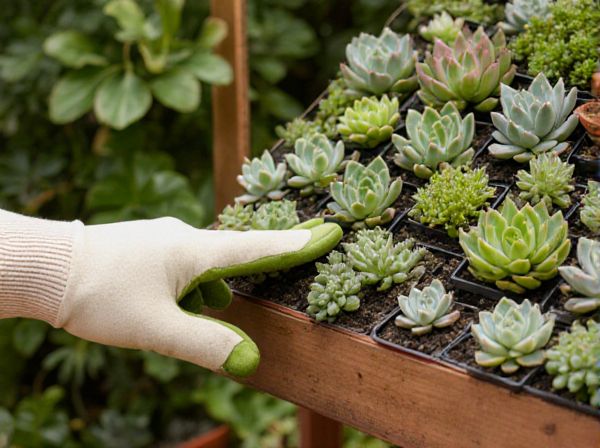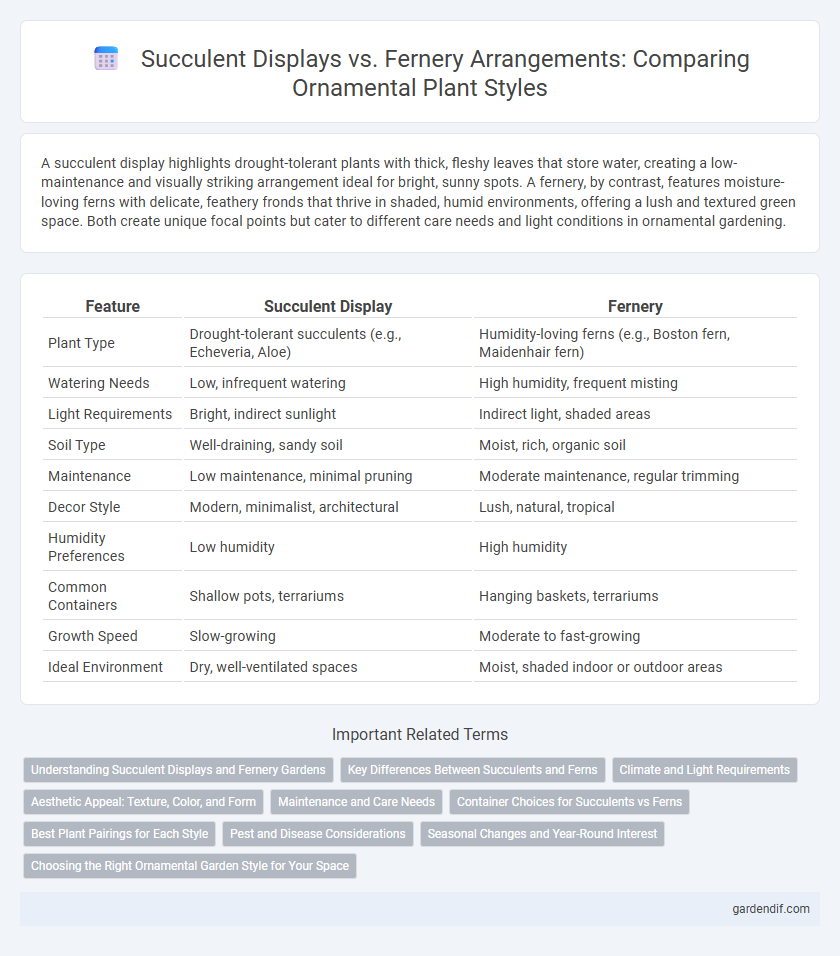
Succulent Display vs Fernery Illustration
A succulent display highlights drought-tolerant plants with thick, fleshy leaves that store water, creating a low-maintenance and visually striking arrangement ideal for bright, sunny spots. A fernery, by contrast, features moisture-loving ferns with delicate, feathery fronds that thrive in shaded, humid environments, offering a lush and textured green space. Both create unique focal points but cater to different care needs and light conditions in ornamental gardening.
Table of Comparison
| Feature | Succulent Display | Fernery |
|---|---|---|
| Plant Type | Drought-tolerant succulents (e.g., Echeveria, Aloe) | Humidity-loving ferns (e.g., Boston fern, Maidenhair fern) |
| Watering Needs | Low, infrequent watering | High humidity, frequent misting |
| Light Requirements | Bright, indirect sunlight | Indirect light, shaded areas |
| Soil Type | Well-draining, sandy soil | Moist, rich, organic soil |
| Maintenance | Low maintenance, minimal pruning | Moderate maintenance, regular trimming |
| Decor Style | Modern, minimalist, architectural | Lush, natural, tropical |
| Humidity Preferences | Low humidity | High humidity |
| Common Containers | Shallow pots, terrariums | Hanging baskets, terrariums |
| Growth Speed | Slow-growing | Moderate to fast-growing |
| Ideal Environment | Dry, well-ventilated spaces | Moist, shaded indoor or outdoor areas |
Understanding Succulent Displays and Fernery Gardens
Succulent displays showcase drought-tolerant plants with thick, fleshy leaves, optimized for low-water environments and vibrant textures. Fernery gardens emphasize shade-loving ferns with delicate fronds, thriving in high humidity and filtered light conditions. Understanding these distinct horticultural environments enhances successful plant care and aesthetic appeal.
Key Differences Between Succulents and Ferns
Succulent displays feature plants with thick, fleshy leaves adapted for water storage, thriving in arid environments and requiring minimal watering. Ferns, typically found in fernery settings, possess delicate fronds and prefer humid, shaded conditions with consistent moisture. The key differences lie in their structural adaptations, watering needs, and environmental preferences, making succulents ideal for drought-tolerant ornamental arrangements while ferns suit lush, moisture-rich displays.
Climate and Light Requirements
Succulent displays thrive in bright, direct sunlight and require well-draining soil with minimal humidity, making them ideal for arid climates or sunlit indoor spaces. Ferns in a fernery prefer shaded or indirect light environments with consistently high humidity and moist, nutrient-rich soil to mimic their natural tropical habitat. Optimal care balances the distinct climate and light needs of succulents, favoring dryness and brightness, versus ferns, which demand moisture and lower light levels.
Aesthetic Appeal: Texture, Color, and Form
Succulent displays offer striking geometric shapes and vibrant hues ranging from deep greens to purples, creating a bold and modern aesthetic. Fernery arrangements emphasize lush, feathery textures with varied shades of green that evoke a soft, natural ambiance. The contrast in form and color between succulents and ferns defines their unique ornamental appeal in decorative spaces.
Maintenance and Care Needs
Succulent displays require minimal watering and thrive in well-drained soil with plenty of sunlight, making them low-maintenance options for ornamental use. Fernery setups demand consistent moisture, high humidity, and indirect light, necessitating regular misting and careful soil moisture monitoring. Succulents are more drought-tolerant and forgiving, whereas ferns need precise environmental control to prevent wilting and maintain lush foliage.
Container Choices for Succulents vs Ferns
Succulent displays thrive in containers with excellent drainage, such as terra cotta or ceramic pots with multiple drainage holes, to prevent root rot by allowing excess water to escape. Ferns prefer containers that retain moisture and humidity, like glazed ceramic or plastic pots with fewer drainage holes, supporting their need for consistently damp soil. Choosing the right container material and drainage design is essential for maintaining the optimal growing conditions specific to succulents and ferns.
Best Plant Pairings for Each Style
Succulent displays thrive with drought-tolerant plants like echeveria, sedum, and aloe, which complement their thick, fleshy leaves and minimalist aesthetic. For ferns in a fernery, ideal pairings include moisture-loving plants such as hostas, calatheas, and maidenhair ferns, which enhance the lush, shaded environment. Choosing plants with similar water and light requirements ensures a harmonious and healthy ornamental arrangement for both succulent and fern gardens.
Pest and Disease Considerations
Succulent displays typically experience fewer pest and disease issues due to their thick, water-retentive leaves and drought-resistant nature, which discourage common pests like aphids and mealybugs. In contrast, ferneries, with their dense, moisture-loving ferns, are more prone to fungal infections and infestations by spider mites and scale insects. Proper air circulation and cautious watering practices are essential in ferneries to prevent mold and mildew, while succulents benefit from well-draining soil to avoid root rot.
Seasonal Changes and Year-Round Interest
Succulent displays maintain vibrant textures and colors throughout dry seasons, thriving in minimal water conditions and bright light, making them ideal for year-round interest in ornamental gardens. Ferneries excel during cooler, wetter months when ferns reveal lush fronds and intricate patterns, offering dynamic seasonal changes that highlight delicate foliage variations. Combining succulents and ferns in display designs balances evergreen resilience with seasonal botanical diversity, enhancing visual appeal across all four seasons.
Choosing the Right Ornamental Garden Style for Your Space
Succulent displays offer low-maintenance, drought-resistant options with vibrant textures ideal for minimalist or modern gardens, while ferneries create lush, shaded environments emphasizing moisture-loving ferns and tropical plants. Choose a succulent display for sunny, arid spaces requiring minimal watering and bold structural aesthetics; opt for a fernery when you want to cultivate humidity and a tranquil, woodland vibe. Matching your garden's light, humidity, and maintenance capacity ensures the best ornamental style to enhance your outdoor space's unique character.
Succulent Display vs Fernery Infographic

 gardendif.com
gardendif.com